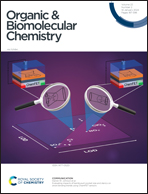Evaluating impacts of bambusuril pocket size and sterics on anion binding trends using ChemFET sensors†
Abstract
Chemically-sensitive Field Effect Transistors (ChemFETs) are a useful tool to evaluate aqueous anion affinity of hydrophobic supramolecular scaffolds. More specifically, ChemFETs can be used to probe impacts of receptor modification to aqueous anion affinity. In this study, ChemFETs are used to evaluate the anion affinity of both dodeca-n-butyl bambus[6]uril and dodecabenzyl bambus[6]uril to assess steric effects in the chemical selectivity of the sensor membrane. The ChemFETs were evaluated through a series of common anions in the Hofmeister series in order to ascertain the difference in detection limit imparted by the specific functionalization of the bambus[6]uril macrocycles, which are quite sensitive to modest steric effects. Significant improvements to perchlorate and nitrate detection limits were observed via n-butyl bambusuril-containing sensor membranes over detection limits recorded with benzyl bambusuril sensors.



 Please wait while we load your content...
Please wait while we load your content...